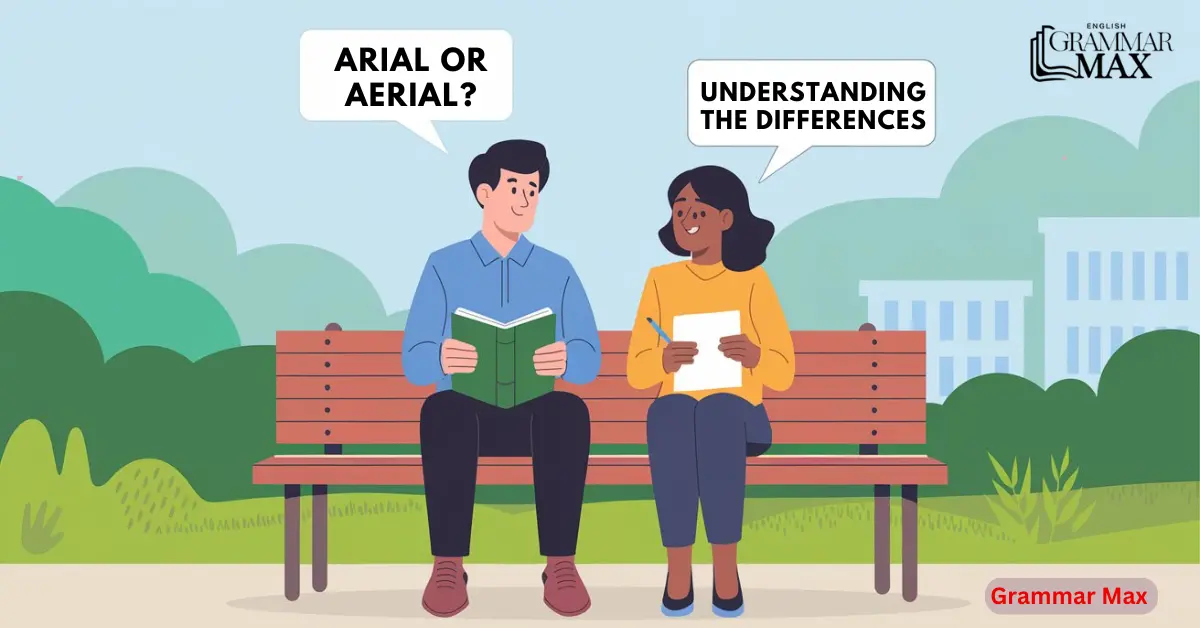Understanding the difference between ‘’Arial’’ and ‘’Aerial’’ is essential for clear communication. Many people mix up these two terms because they sound similar, but they mean very different things. Arial is a widely used font known for its clean and modern look, while Aerial refers to anything related to the air or atmosphere.
In this article, we’ll explore each term in detail, clarify their uses, and help you avoid common mistakes. Whether you’re writing a report, creating a presentation, or simply trying to improve your language skills, knowing how to use these words correctly will enhance your writing. Let’s dive in!
Understanding Arial and Aerial
Although they seem to possess a comparable sound to one another, Arial and Aerial denote differing things. To begin with, Arial is a common sans-serif font face that’s famous in print and other forms of media. On the other hand, Aerial refers to things that are above ground or involve the sky or air activities.
Such situations tend to occur a lot when it comes to writing especially when one is keen on their accuracy. The wrong application of these terms can affect the audience’s perception of the communicated message which makes it very important to comprehend the concepts.
As we look into these terms more in-depth, we will also point out what each term’s meanings, situations, and usages in the real world are. And it will be beneficial in reducing the incidences of such problems while improving communication.
Arial: Definition and Usage
Arial was published as a sans serif typeface by Monotype in 1982 by designers Robin Nicholas and Patricia Saunders. Its clean lines and modern aspect made it heavily used in digital media. In contrast with serif fonts, which have small ornamental strokes at the ends of some letters, sans serif fonts such as Arial do not have these strokes. The same aspect contributes to effective reading longitudinally as well, especially on the screens.
Arial font is also used in newspapers, websites, and presentation slides. A lot of companies and institutions tend to use it because it gives an official look. It is also used in place of Helvetica typeface especially when it is not available. Wherever you go for instance in Microsoft Word or Power Point that is where many people apply Arial font making it very common in offices and schools as well.
Aerial: Definition and Usage
On the other hand, Aerial refers to anything related to the air or atmosphere. It comes from the Latin word “aer,” meaning air. The term encompasses various contexts, such as aerial photography, where images are captured from above using drones or aircraft, and aerial acrobatics, a performance art involving gymnastic feats in the air.
Athletic activities often include elements of aerial performance, as is the case in aerial ice skiing or aerial silk performances when the performers execute remarkable tricks and or routines in the air. In those examples, the term “aerial” is used to signify a vertical space and reach which makes the activity very thrilling.
In common parlance, people might use phrases like ‘aerial view’ meaning a viewing aspect that is above the subject, which without understanding the depth of aerial perceptual way may seem scale problematic. Aerial also understates many meanings of imagery; Hence If a writer wishes to make more visual communication, then the writer ought to comprehend ‘aerial’ in other contexts.
Side-by-Side Comparison
When it comes to understanding Arial and Aerial, a side-by-side comparison can highlight their distinct characteristics. While both terms may sound similar, they serve very different purposes in language and design. Below, we’ll explore their differences in detail, followed by a table summarizing the key points for quick reference.
Arial is a font that can be classified as sans serif. It is designed to be simple and easy to read, hence Arial’s popularity in digital media such as websites, text documents, and presentation slides. Additionally, its clean lines also make it a good option for reading materials, especially for online content. The font is also popular in most offices since it gives a contemporary and more sophisticated feel.
In contrast, Aerial is an adjective that refers to anything that relates to the sky or the atmosphere. This is commonly used in phrases, for instance, aerial photography, which is taking pictures from above, and aerial acrobatics, which involves flying performers. Aerial is all things height, distance, or the space above the ground.
To summarize these differences more clearly, here’s a comparison table:
| Feature | Arial | Aerial |
| Type | Font (sans-serif typeface) | Adjective (related to air) |
| Usage Context | Digital documents, websites, design | Photography, sports, performances |
| Pronunciation | /ˈɛəriəl/ | /ˈeəriəl/ |
| Example | Used in a presentation or report | Referring to aerial views of a city |
| Focus | Visual design and readability | Height and atmosphere |
Understanding these differences is crucial for effective writing and communication. By knowing when to use Arial or Aerial, you can enhance your clarity and ensure your message is received as intended.
Everyday Usage Examples
Understanding how to use Arial and Aerial in everyday language can help prevent confusion and improve communication. Below is a detailed table that provides various scenarios and examples to illustrate the correct usage of each term in different contexts.
| Context | Example Sentence with Arial | Example Sentence with Aerial | Explanation |
| Business Communication | “Please format the report using Arial font for consistency.” | “The aerial view of the city helped us plan the new layout.” | In business settings, Arial is preferred for document formatting, while aerial views enhance urban planning. |
| Graphic Design | “The flyer uses Arial for all the text to ensure readability.” | “We included an aerial shot of the landscape in the brochure.” | Graphic designers often choose Arial for its clarity, while aerial shots can provide a stunning visual impact. |
| Academic Writing | “I submitted my thesis in Arial font as per the guidelines.” | “The study analyzed aerial data to assess environmental changes.” | In academic work, Arial is commonly used for formatting, whereas aerial data can offer insights from above. |
| Website Design | “The website’s typography uses Arial for its clean look.” | “The site features an aerial image of the event location.” | Web designers often choose Arial for text, while aerial images can attract visitors by showcasing location features. |
| Social Media Posts | “I shared an article written in Arial for better readability.” | “Check out these aerial photos of the festival from last year!” | Posts may link to articles formatted in Arial, while aerial photos can engage users by providing a unique perspective. |
These examples demonstrate how to use Arial and Aerial correctly in various everyday contexts. By being mindful of the proper term, you can communicate more effectively and enhance your writing.
Frequently Asked Questions
What is the primary difference between Arial and Aerial?
The main difference is that Arial is a sans-serif font used primarily in digital documents and designs, while Aerial refers to anything related to the air or atmosphere. Understanding this distinction helps clarify their usage in writing.
When should I use Arial in my documents?
You should use Arial when you want a clean, modern look in your documents. It’s a versatile font that works well in reports, presentations, and web content, making it suitable for professional settings.
Can I use Aerial to describe a font?
No, using Aerial to describe a font is incorrect. Aerial pertains to things related to air, such as aerial views or aerial photography. Instead, use Arial when discussing the font style.
Why do people confuse Arial and Aerial?
People often confuse Arial and Aerial because the two terms sound similar. Additionally, their distinct meanings can lead to mix-ups in writing, especially when discussing visual content or font choices.
Are there other terms that commonly get confused like Arial and Aerial?
Yes, several pairs of words can lead to confusion, such as “compliment” and “complement” or “affect” and “effect.” Being mindful of such distinctions can improve your writing clarity and effectiveness.
Conclusion
The differences between Arial and Aerial are vital for effective communication. Arial is a clean, modern font suitable for various contexts, while Aerial pertains to anything associated with the air. Being aware of these distinctions not only enhances your writing but also ensures your message is clear.
Common mistakes include confusing the two terms or using them interchangeably. To avoid this, keep their definitions in mind, and consider the context in which you’re writing. By doing so, you’ll improve your clarity and professionalism in communication, making your writing more engaging and accessible.

William Henry is a writer for Grammar Max, a blog that focuses on synonyms and phrases. He loves exploring the quirks of the English language and enjoys helping readers improve their vocabulary. William’s articles are easy to read, fun, and full of useful tips for anyone looking to better understand and use English. Whether you’re a student, a professional, or just someone interested in language, William’s writing on Grammar Max makes learning about words and their meanings simple and enjoyable.















